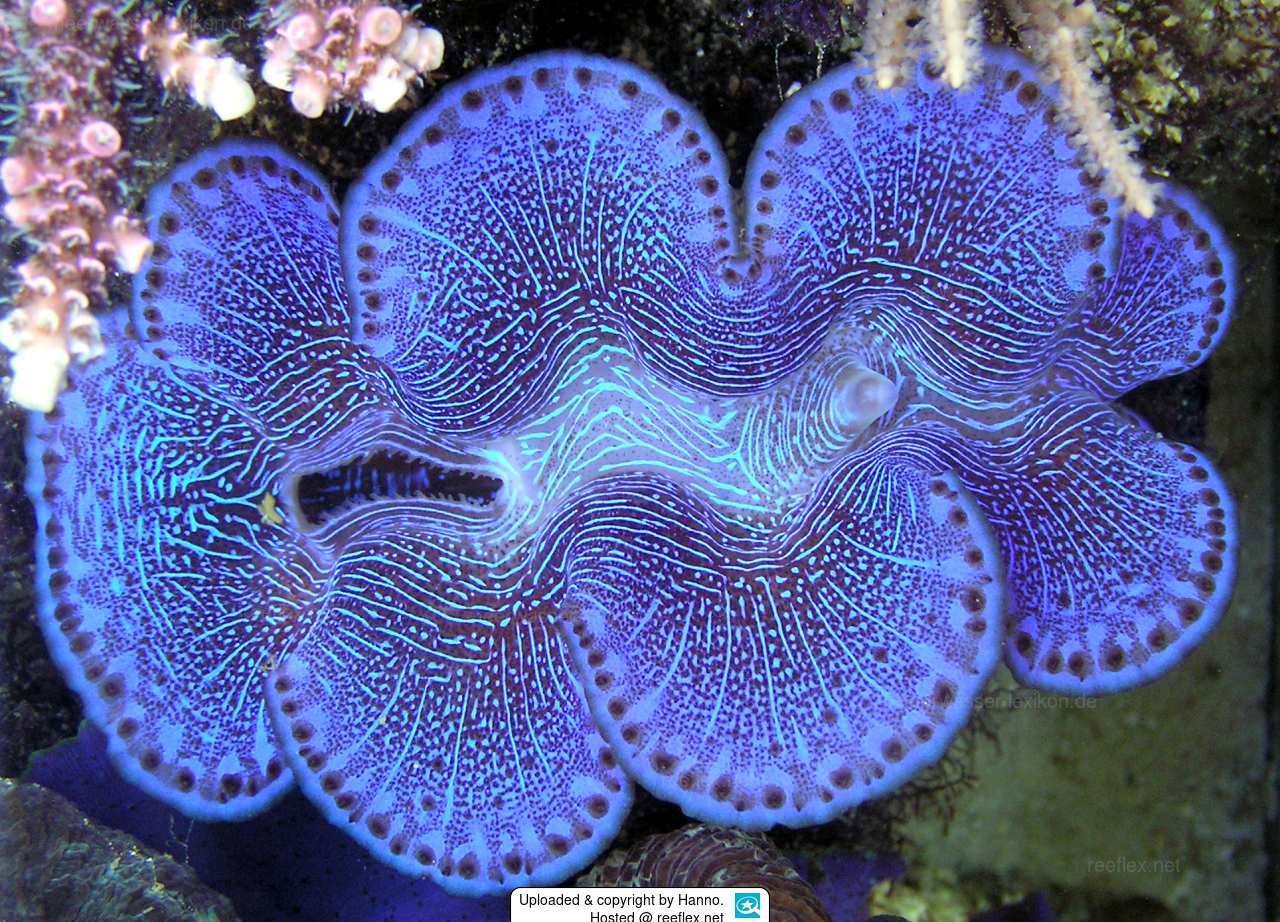Info
(Röding, 1798)
Giant clams (Tridacninae) are a bivalve subfamily. They belong to the family of cockles (Cardiidae) and thus to the order Cardiida. For some time now, giant clams have been threatened with extinction due to overfishing, pollution and as a result of the climate phenomenon El Niño. They are on the list of the Washington Convention on International Trade in Endangered Species.
Today, efforts are being made to preserve the species through selective breeding. In Asia, it is believed that eating the meat, especially the sphincter, has an aphrodisiac effect.
It has received the name killer mussel because it is able to hold fish or even an arm by closing the shells. So there is one or the other documentation that pearl divers could not free themselves from a mussel and drowned. DieSes one can observe often also with Putzerlippfishes, not few had to leave your life, because the mussel resisted with plucking the Lippfish and snapped.
About aquaristics:
Giant clams need high illumination and optimal water conditions (like all animals). Mussels should also only be introduced into tanks that have matured somewhat. If possible, keep them free of thread algae, small sea anemones, glass lice... The temperature in the aquarium should not exceed 28 degrees.
Attention - lanthanum treatment can lead to problems or losses. If possible, remove them from the tank during the treatment period.
About aquaristics:
Giant clams require high light levels and optimal water conditions (like all animals). Mussels should also only be introduced into tanks that have matured somewhat. If possible, keep them free of thread algae, small sea anemones, glass lice... The temperature in the aquarium should not exceed 28 degrees.
Attention - lanthanum treatment can lead to problems or losses. If possible, remove them from the tank during the treatment period.
Tridacnene in nature mechanically and chemically bore into corals and attach themselves with byssus threads. In order to get the animals, whole coral blocks are smashed when caught in the wild, therefore please always prefer the offspring (NZ), even though they are more expensive.
Tridacna crocea is more susceptible than the other species, because its foot opening is much larger and therefore wrasses and bristle worms can reach it more easily.
It is important when buying that the animal is not stuck and then torn off, because this causes bacterial infections very quickly, which the mussels usually do not survive. It would be best if it has attached itself to small stones and you buy it with the stone. Often it is the less good conditions in the aquarium that weaken the mussels too much.
In the tank itself it needs a quiet place with the brightest possible lighting, where it can stand safely and also not fall down. It takes some time for it to reattach itself by itself.
Very young tridacnas can also migrate, only the adults live sessile - mostly due to the weight of the shell.
The mussel feeds mainly on the products of its zooxanthellae.
The most interesting are their thousands of photoreceptors, with which they can see moving objects. These receptors are located in the broad mantle lobes and also ensure that light is focused to reach the zooxanthellae. (light guide effect).
The zooxanthellae are picked up while still in the larval stage, although it is still not known exactly how the bivalve does this. There is a theory that the dinoflagellates (zooxanthellae) are eaten and absorbed in the gut by special bladder cells and transported through the body to the mantle lobes where they are stored. The stored zooxanthellae enable the enormous growth rates to be achieved and the mussel to hold its own against the competitive pressure of the light-active corals.
It is assumed that e.g. Tridacna crocea can reach an age of 40 - 50 years, but with a final size of 15 cm it is the smallest species of the family Tridacnidae.
Synonyms:
Tridachnes maxima Röding, 1798
Tridachnes noae Röding, 1798
Tridacna (Chametrachea) maxima (Röding, 1798)
Tridacna acuticostata G. B. Sowerby III, 1912
Tridacna compressa Reeve, 1862
Tridacna elongata Lamarck, 1819
Tridacna elongatissima Bianconi, 1856
Tridacna fossor Hedley, 1921
Tridacna imbricata (Röding, 1798)
Tridacna lanceolata Sowerby II, 1884
Tridacna maxima var. fossor Hedley, 1921
Tridacna mutica Lamarck, 1819
Tridacna reevei Hidalgo, 1903
Tridacna rudis Reeve, 1862
Tridacna troughtoni Iredale, 1927
am 26.12.23#14
Hallo,
also wenn man das so liest, könnte man denken, es ist überhaupt kein Problem diese Muscheln zu halten, was aber einfach nicht richtig ist.
Ich hatte schon in den 80er und 90ern Becken mit Korallen, auch da hatte ich bereits Muscheln und wenig Probleme mit den Tieren.
Als ich nun vor zwei Jahren wieder anfing nach vielen Jahren Pause wo ich mich auf meine Familie und Kinder konzentrierte, bin ich begeistert was heute alles möglich geworden ist
in der Riffaquaristik. Steinkorallen wachsen heute selbstverständlich in den schönsten Farben im Aquarium. Ich richte mir gleich zwei Becken ein in denen bis heute die schönsten und empfindlichsten Steinkorallen wachsen. Nur mit Muscheln hatte ich nach unzähligen Versuchen kein Glück, nach wenigen Wochen oder vielleicht mal 2 Monate, dann gingen sie ein, einen Fressfeind konnte ich nie entdecken. Da mich schon früher in den 90ern Dinge ärgerten die nicht funktionierten und ich bis zur Lösung vorantrieb (auch einige Berichte veröffentlichte), z. Bsp. Kalkreaktor weiter entwickelte bis ich einen kompletten Lebenszyklus von Korallen im Aquarium abbilden konnte, wollte ich auch diesen Problem lösen. Zunächst schaute ich nach Literatur und fand das Buch von Daniel Knop "Riesenmuscheln". Herr Knop halte ich für einen sehr engagierten Autor der viel für unser Hobby tut und tolle Bücher schreibt in denen er uns verständlich die Zusammenhänge erklärt.
Das Buch über Riesenmuscheln ist gut, Arten werden auch sehr gut beschrieben und man erfährt viel über die Zucht. Doch über Probleme im Aquarium mit den Muscheln und die Eingewöhnung steht leider wenig drin. Eine Anleitung wie geht man genau vor wenn man eine Muschel erworben hat, wie kann ich was deuten ob der Muschel was nicht behagt und wie gehe ich damit um. Was bedeutet was, z. Bsp. wenn eine Muschel mal 1-2 Tage zu ist- ist das normal ? Was läuft falsch wenn nach drei Monaten die Muscheln immer sterben, alle Wasserwerte sind laut Labor aber ok, und auch kein Fressfeind im Aquarium. Seltsamerweise halten die Derasa-Muscheln länger obwohl diese laut Autor empfindlicher sein sollen als Maxima. Keine Erklärung zu Muschelhaltern und ob es für eine Muschel wichtig ist festzuwachsen ? Warum stehen die Muscheln bis zum letzten Tag gut da und am nächsten sind sie tot ? Vieles bleibt leider unbeantwortet und der Teil der Aquarienhaltung kommt zu kurz. Das Kapitel Wasser und Wasserwerte wird mit dem Argument abgetan, es würde schon in vielen anderen Büchern über Riffaquaristik behandelt und Muscheln haben das gleiche Bedürfnis. Da ist der Autor aber ganz gewaltig auf dem Holzweg, ich konnte gegenteiliges feststellen, denn in einem Steinkorallenbecken, können Acropora Korallen und andere prächtig wachsen und die Muscheln gehen ein. Was muß da laut den "Muschelspezialisten" nicht alles herhalten, Fische, Borstenwürmer, Krabben und andere angebliche Räuber. Ich konnte nach unzähligen toten Muscheln und viel Geld feststellen, dass die Muscheln wahrscheinlich in solch einem Aquarium verhungern weil eben das Wasser nicht passt und keine Nährstoffe enthält C, N, P zum Beispiel. Es reicht nicht wenn man in einem Muschelbuch nicht darauf eingeht und lapidar schreibt, man solle 1 mal wöchentlich 1 Spurenelementlösung reinkippen von einem namhaften Hersteller - Was ist das denn für eine Vorschlag ? Manches Zuviel an Spurenelemente wirkt sofort giftig auf die Muscheln, wo andere Korallen noch gut dastehen. Es gibt m. E. zweierlei was Muscheln im Wasser unbedingt brauchen, Grundelemente wie die Mineralien und Spurenelemente aber auch Nährstoffe. Ich kam drauf als ich mich wunderte wie lange die Muscheln in den Gammelbecken bei den Händlern überleben und bei mir nach wenigen Wochen oder Tagen sterben, obwohl die Bedingungen bei mir soviel besser waren. Sterben oder degenerieren die Zooxanthellen aufgrund Nahrungsmangel (auch Licht) kümmert die Muschel. Also bei Problemen auch mal überlegen ob das Wasser nicht zu sauber ist. Da ich immer solange suche bis es zur Lösung kommt, hatte ich mit einigen langjährigen Händlern Kontakt und ich tastet mich an das Problem langsam ran. Zuerst ließ ich immer monatlich ein ICP Laboranlalyse machen um die Wasserwerte zu beobachten, zusätzlich fütterte ich täglich Plankton und nutzte von Fauna Marin das Amin, Coral Soft und von Red Sea das Reef Energy Plus, dann wurde es besser (bei 10% Wasserwechsel im Monat). Schlussendlich scheint es so zu sein: Schon beim Kauf ist darauf zu achten dass die Muschel gesund ist und ausreichen beleuchtet wurde (nicht nur das blaue Funzellicht), am besten kräftige Farben (kein fahles blau oder sogar transparente Stellen), am besten sie kommt noch fest auf einem Muschelhalter gewachsen. Leider sind Muscheln schon geschädigt, wenn sie beim Händler mehre Wochen falsch gehalten werden in dunklen Becken, kommt sie dann zu einem ins Aquarium unter ordentliches Licht verkraftet sie das nicht mehr und geht ein. Hat man eine gute gesunde Muschel bekommen ist der Standort entscheidend und kann ein andere sein als der den wir gedacht haben, vielleicht ist es der Muschel anfangs auch zu hell und sie regelt dies mit geschlossenen Schalen nach wenigen Stunden Licht. Ist die Muschel wenige Wochen da und öffnet sich, darauf achten ob sie wächst ) oberer Schalenrand sollte immer blütenweiß sein. Die Wasserwerte sollten nicht "zu sauber" sein, Nitrat und Phosphat sollte nachweißbar sein und die Spurenelemente nach ICP einstellen. Dann noch füttern mit Plankton, Fauna Marin Amin, Reef Energy Plus, Calcium und KH im Auge behalten. Laut einem langjährigen Händler den ich sehr schätze ist das mit den Muscheln nicht immer einfach, hier war es wohl in den 90ern einfacher in den Becken mit Weichkorallen für die Muscheln und die erhöhten Nitrat Phosphatwerte haben vieles ausgeglichen. Bei einem Weichkorallenbecken sogar mit T5 Beleuchtung halten die Muscheln sehr gut, bei sehr sauberen bunten Steinkorallenbecken vermute ich die Schwierigkeiten weil sie langsam verhungern. Das ist eine Vermutung und Erfahrung die ich hier mitteile, wenn jemand andere Ideen und Erfahrungen hat bin ich sehr dankbar sie zu erfahren. Hier meine Mail: juergen.auchter@kabelbw.de
am 10.04.22#13
Moin,
ich halte eine Tricacna Maxima seit ca. 2,5 Jahren. Ich habe sie damals mit unter 4 cm Länge eingesetzt. Nun ist sie 13 cm lang und zig mal so schwer. Habe sie gerade gemessen. Das kleine 175L-Becken stand zum Zeitpunkt des Einsetzens ca. 1,5 Jahre. Es gab durchaus Zeiten, in denen ich nicht so auf die Wasserwerte geachtet habe und in denen manche Korallen auch etwas gelitten haben. Die Tridacna hat alles ohne Probleme weggesteckt und war immer offen.
Ich denke also, wenn das Becken eingefahren ist und das Licht stimmt (Ich beleuchte mit einer starken LED), die Strömung nicht zu stark ist und keine Tiere sie belästigen, dann sollte die Haltung gut gehen. Wenn sich einfache SPS wie z.B. Stylophora "Milka" halten lassen, dann sollte es auch der Tridacna gut gehen.
Es wurde schon geschrieben, dass man beim Kauf sich das Tier auch durch die Scheibe ansehen sollte. Die Farbe sieht da doch anders aus und meist weniger attraktiv als von oben. Meine ist von oben grell türkis und von der Seite durch die Scheibe dunkelblau, aber immer noch wunderschön. Gibt aber auch welche, die da dann eher etwas blass wirken.
am 25.03.22#12
Ich würde die Haltung nicht als anspruchsvoll bezeichnen - im Gegenteil. Ich habe seit ca. 1,5 Jahren ein ursprünglich 3cm großes Expemplar in meinem Aquarium, das inzwischen auf ca. 10 cm angewachsen ist. Wenn der Standort stimmt, muss man sich um diese schöne Muschel eigentlich überhaupt nicht kümmern -sie wächst und gedeiht von alleine.
Einigermaßen stabile Wasserwerte sollte man ohnehin auch für die restlichen Aquarienbewohner haben, daher, das setze ich mal voraus...







 Hanno
Hanno
















































